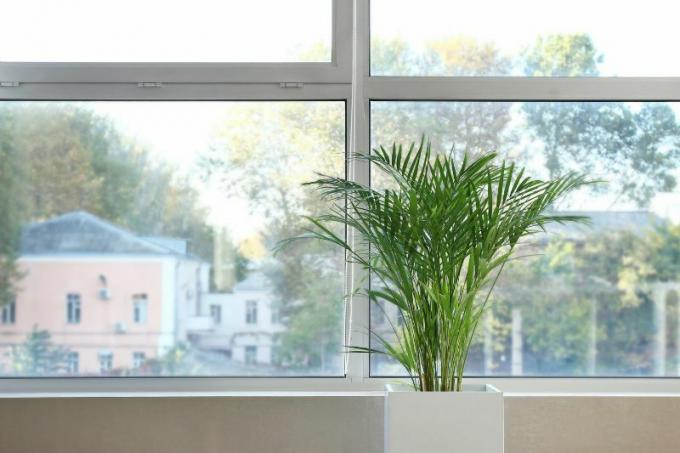
The exotic golden fruit palm has been one of the most popular indoor plants for years. It conveys a wonderful holiday atmosphere and at the same time ensures a healthy indoor climate. But the golden fruit palm needs a bright location.
In a nutshell
- loves a bright and warm location
- sensitive to drafts
- needs high humidity
- Possibility to stay outside in summer
- repot every two to three years
Table of contents
- loves it light
- Evenly moist substrate
- Hydroponics possible
- Off into the open
- Frost-free overwintering
- frequently asked Questions
loves it light
The gold fruit palm (Dipsis lutescens), also known as the areca palm, originally from Madagascar, grows in its homeland in areas close to rivers or in rainy, small forests. There they prefer sunny locations. However, the gold fruit palms cultivated in this country are no longer used to full sun. The leaf fronds would get sunburned. In general, the culture of the palm tree is not very difficult. It is also suitable for beginners, but there are a few things to keep in mind. Important for a healthy growth of golden fruit palm is the ideal location:
- bright
- no full sun
- Lighting conditions 800 to 1000 lux
- Temperatures between 18 and 24 °C, optimally 20 °C
- a little cooler at night, but not below 18 °C
- avoid extreme temperature fluctuations
- no draft
- high humidity

Notice: In this country, the areca palm reaches a final height of three meters. Their overhanging fronds are up to two meters long and grow from a yellow coated leaf base.
Evenly moist substrate
The basis for good growth is the substrate. It must be evenly moist, but not wet. In addition, it should have other properties such as:
- rich in humus and nutrients
- loose and well drained
- slightly acidic pH (5.0 to 6.5)
High-quality uniform potting soil or special ones are best suited for planting green plant soil. In order for the soil to retain good drainage, it is advisable to mix in 30 percent pumice stone, sand or lava gravel. In addition, the soil itself can also be produced. Simply mix the following ingredients together:
- part compost
- part loam or clay
- some quartz sand
Hydroponics possible
The areca palm is also popular hydroponics rightly so. Culture takes place here without soil. but in a nutrient solution or water. The planting takes place either in expanded clay or lava granules or expanded slate. This gives the plant enough support and the roots are supplied with sufficient air. The planted pot is then placed in a planter filled with water. The water consumption can be seen via a water level meter. The golden fruit palm is supplied with nutrients through the administration of special hydroponic fertilizer. As a result of hydroponics, there is always a correspondingly high level of humidity.
Off into the open
During the summer months, the golden fruit palm appreciates a sheltered spot outdoors. After the ice saints, when the temperatures remain constant and cold days are no longer to be expected, she can move to the garden, balcony or terrace. The golden fruit palm has to get used to the new location slowly. For this purpose, the palm tree is initially only placed outside for a few hours. On cool nights she comes back into the house. The ideal outdoor location for the golden fruit palm looks like this:
- light to slightly semi-shady
- no direct sunlight
- constant temperatures around 18 °C
- protected from wind and rain

Places on walls or near trees and bushes are particularly suitable. These offer the golden palm tree protection from direct sunlight.
Notice: The palm owes its name to its up to 60 centimeters long yellow panicles of flowers. Unfortunately, no flowering takes place in room culture.
Frost-free overwintering
The golden fruit palm must move to its winter quarters in good time because it is not frost hardy. When the daytime temperatures fall below 15 degrees Celsius in autumn, it is time to bring the plant back inside. Before that, you have to open it thoroughly pests to be examined. Hibernation takes place:
- bright
- Light conditions at least 800 lux
- full sun exposure is tolerated
- Temperatures between 15 and 20 °C are ideal
- not below 15 °C
- possible use of artificial light
- ideal location: conservatory

Avoid dry heating air. Setting up bowls filled with water and spraying the plant regularly can help. The golden fruit palm rests between December and February. It then has to be watered less and not fertilized.
frequently asked Questions
The substrate of the tropical houseplant must not be too wet, but also not too dry. It is extremely sensitive to waterlogging. The following applies: the warmer the plant is, the more often it has to be watered. Daily watering is necessary in summer. On the other hand, there is less watering in winter. However, the root ball must always be slightly moist. Rainwater or stagnant, low-lime tap water is best suited. The golden fruit palm is also excellent for hydroponics.
Young specimens are repotted annually. For larger palm trees, repotting every two to three years is sufficient. A larger pot will be necessary at the latest when the pot is completely rooted. Since the golden fruit palm forms a taproot, the new pot should be deeper and only a few centimeters wider in diameter. A large drainage hole is important. The roots must not be damaged when transplanting. The best time for repotting is spring to summer.
First of all, there is something wrong with the location. Brown leaf tips are the first signs before the fronds turn completely yellow. On the one hand, too little light can be a cause. However, discoloration usually occurs when the humidity is too low. Especially in winter, the room climate is very dry due to heating. Affected tips are simply cut off and the plant is regularly sprayed with low-lime water. In addition, care errors such as not giving enough water can cause brown tips.
